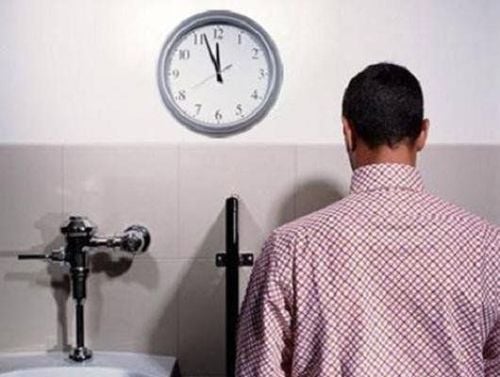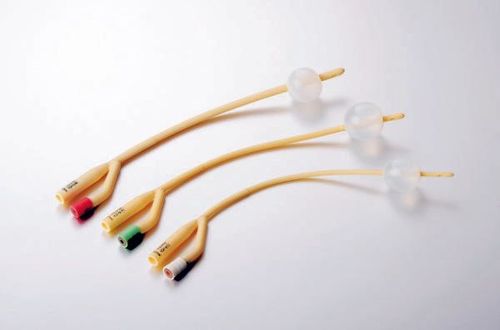This is an automatically translated article.
The article is expertly consulted by Master, Doctor Le Phuc Lien - Urologist - Department of General Surgery - Vinmec Nha Trang International General Hospital. The doctor has more than 12 years of experience in the field of urology and specialized urology.Catheterization is a procedure used to diagnose and treat some diseases of the urinary tract, this method is done by draining urine out through a tube placed from the orifice to the bladder.
Anatomically, the urethra in men is long and not straight, but shaped like a Z, so catheterization in men often faces many difficulties, so male catheterization technique must be recommended. access and training.
1. Purpose of male urinary catheter

Thủ thuật đặt thông tiểu ở nam giới thường gặp rất nhiều khó khăn
Urinary catheterization is a method to treat urinary tract diseases by using a catheter inserted through the urethra into the bladder to drain urine, for the purposes of:
Reducing or eliminating discomfort and excessive strain level due to stagnation of urine in the bladder. Urinalysis helps measure the volume and nature of urine in the bladder. Take a urine sample to conduct the necessary tests. Cleaning the bladder in necessary cases such as surgery of the anogenital area, surgery or cystoscopy of the patient's urinary tract. Monitor urine output in patients with shock, poisoning, or severe burns.
2. When should a male urinary catheter be inserted?
Need to place a urinary catheter in the following cases:
The patient has diseases that cause urethral obstruction such as: prostate enlargement, prostate cancer, urethral stricture. Patients with disorders in urine excretion: Urinating not all the urine in the bladder, trying to urinate but can't, urinary retention have applied measures to stimulate urination but it is not effective... In course of treatment when monitoring of urine output is required in critically ill or traumatized patients. Take a sterile urine sample to do tests for the diagnosis of the disease. After surgery. Nervous system-related bladder dysfunction, eg in patients with spinal cord injury. Do not use urinary catheter in the following cases:
The patient has a ruptured urethral tear. Experiencing prostate injuries. Urinary tract infection. In the above cases, if urinary catheterization can cause further damage to the urethra, making the disease worse.
3. Points to note when catheterizing male urinary tract
For safe and effective urinary catheterization, the following issues should be noted:
Instruments (especially catheters) must be absolutely sterile to avoid infection upstream. The technique used must be in accordance with the procedures and aseptic hygiene. The movement must be done very gently, not harshly or forcefully if it is difficult to do it again or ask the patient to open and breathe evenly to reduce urethral spasms. Urine must be collected in the middle of the field (if it is necessary to collect urine for bacteria testing), it should be collected directly into a sterile test tube. Do not leave the catheter in place for more than 48 hours. Do not pass urine several times a day. If the patient with urinary retention must withdraw urine slowly and not completely empty the bladder will reduce pressure suddenly and cause bleeding. Monitor patients during and after catheterization to detect abnormalities and promptly handle them.
4. Prepare the patient for urinary catheterization

Kỹ thuật thông tiểu nam cần được tiến hành đúng quy trình trong điều kiện vô khuẩn để đảm bảo an toàn và hiệu quả điều trị
Inform the patient about the technique to be performed, explain the procedure, content and purpose so that the patient or patient's family knows what to do to help them feel secure, instruct the patient on how to inhale gently to relax bladder sphincter if necessary. For mild cases: Prepare water in advance so that the patient can clean the external genitals by themselves before performing urinary catheterization. For severe cases: First, spread a plastic sheet on the bed, put a flatbed under the patient's buttock, have the patient lie on his back with his knees bent against the bed and slightly bent. Then wash the external genitals with dilute soapy water or cooled boiled water, wash from top to bottom, inside to outside, when done, empty the dirty water, wash the flatbed and put it back under the patient's bottom. . The nurse washes her hands with soap.
5. Procedure for performing male urinary catheterization technique
The nurse wears a mask, washes her hands, re-checks the equipment, location and patient, then conducts male urinary catheterization.
Male urinary catheterization is performed according to the following procedure:
Take a cloth to cover the patient and take off his pants, wrap the cloth to put on the patient's legs. Pour a sufficient amount of antiseptic solution into the bowl of vultures that have gauze swabs. The nurse disinfects hands and puts on sterile gloves. Then spread a surgical towel with holes to expose the patient's penis to the outside. Apply paraffin oil to the catheter with a length of 7-10cm. The nurse's left hand pulls the foreskin down to reveal the urinary hole, the right hand holds the gauze pliers to soak the antiseptic solution on the glans from the urinary hole to the outside. Hold the penis upright with one hand so that the penis is at a 90-degree angle to the patient's body, the other hand holds the catheter, slowly inserting it into the urinary opening about 10cm, then lower the penis and place it parallel to the abdominal wall. The catheter floats into the bladder on its own until urine is seen. Then insert the catheter about 18 - 20cm deep. During the procedure, if the nurse finds it difficult or entangled, tell the patient to breathe hard and slightly tell the tube to be easy to enter, if it is difficult to put in, do not continue to push the catheter, have to pull it out and do it again. When the catheter has entered the bladder, depending on the indication, collect urine for testing or remove urine. Remove the male urinary catheter to insert into the bean tray. Use a syringe to drain the water out of the balloon. Squeeze the tube and then slowly pull it out and put it in the bean tray. Disinfect the urethral opening with an antiseptic solution, clean the genital area and wipe it dry. Pull up the patient's pants and leave the patient in a comfortable position. Clean up used tools, wash them and send them to autoclave for sterilization. Other tools arranged in the right place. The technique of male urinary catheterization needs to be carried out according to the correct procedure in aseptic conditions to ensure safety and effectiveness in treatment. When there are signs and symptoms such as: blood in the urine or bleeding from the urethra, no improvement in symptoms when urinating, symptoms of infection are fever, lower abdominal pain, redness, swelling, pain in the muscles genitalia, ... should immediately notify the medical staff for timely handling.
Vinmec International General Hospital is one of the hospitals that not only ensures professional quality with a team of leading medical doctors, a system of modern equipment and technology. The hospital provides comprehensive and professional medical examination, consultation and treatment services, with a civilized, polite, safe and sterile medical examination and treatment space.
Please dial HOTLINE for more information or register for an appointment HERE. Download MyVinmec app to make appointments faster and to manage your bookings easily.













